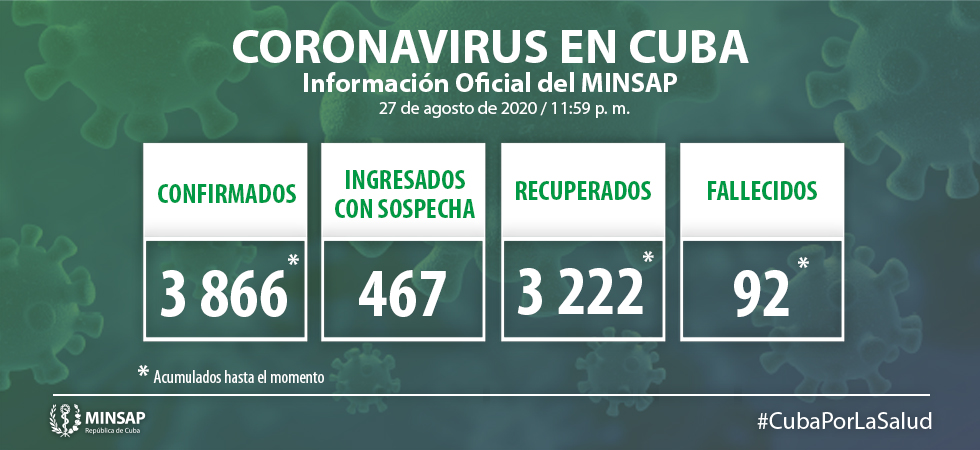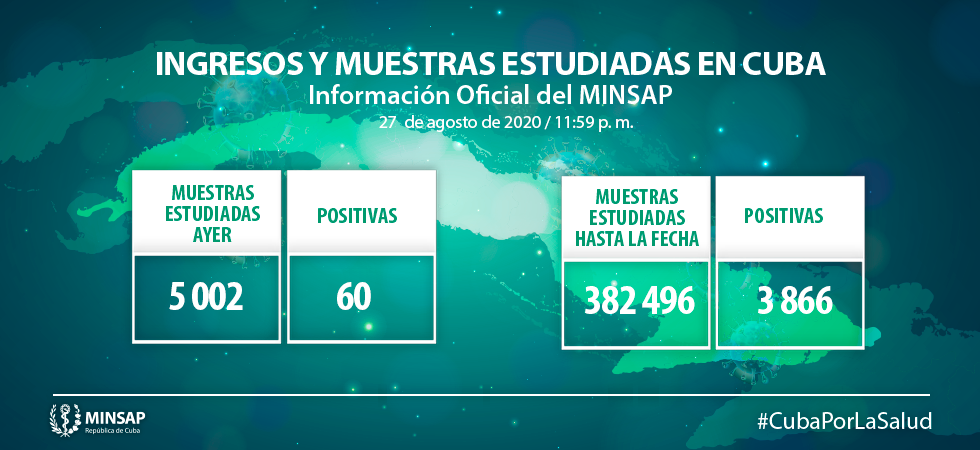| TERAPIA CON ANTICUERPOS |
|---|
| 28-08-2020 16:27 | | A novel biparatopic hybrid antibody-ACE2 fusion that blocks SARS-CoV-2 infection: implications for therapy. | | A novel biparatopic hybrid antibody-ACE2 fusion that blocks SARS-CoV-2 infection: implications for therapy. MAbs. 2020 Jan-Dec;12(1):1804241 Authors: Miao X, Luo Y, Huang X, Lee SMY, Yuan Z, Tang Y, Chen L, Wang C, Wu F, Xu Y, Jiang W, Gao W, Song X, Yan Y, Pang T, Chen C, Zou Y, Fu W, Wan L, Gilbert-Jaramillo J, Knight M, Tan TK, Rijal P, Townsend A, Sun J, Liu X, James W, Tsun A, Xu Y Abstract
In the absence of a proven effective vaccine preventing infection by SARS-CoV-2, or a proven drug to treat COVID-19, the positive results of passive immune therapy using convalescent serum provide a strong lead. We have developed a new class of tetravalent, biparatopic therapy, 89C8-ACE2. It combines the specificity of a monoclonal antibody (89C8) that recognizes the relatively conserved N-terminal domain of the viral Spike (S) glycoprotein, and the ectodomain of ACE2, which binds to the receptor-binding domain of S. This molecule shows exceptional performance in vitro, inhibiting the interaction of recombinant S1 to ACE2 and transduction of ACE2-overexpressing cells by S-pseudotyped lentivirus with IC50s substantially below 100 pM, and with potency approximately 100-fold greater than ACE2-Fc itself. Moreover, 89C8-ACE2 was able to neutralize authentic viral infection in a standard 96-h co-incubation assay at low nanomolar concentrations, making this class of molecule a promising lead for therapeutic applications.
PMID: 32804015 [PubMed - indexed for MEDLINE] |
|
| 28-08-2020 16:27 | | Potent neutralizing antibodies against multiple epitopes on SARS-CoV-2 spike. | | Potent neutralizing antibodies against multiple epitopes on SARS-CoV-2 spike. Nature. 2020 08;584(7821):450-456 Authors: Liu L, Wang P, Nair MS, Yu J, Rapp M, Wang Q, Luo Y, Chan JF, Sahi V, Figueroa A, Guo XV, Cerutti G, Bimela J, Gorman J, Zhou T, Chen Z, Yuen KY, Kwong PD, Sodroski JG, Yin MT, Sheng Z, Huang Y, Shapiro L, Ho DD Abstract
The severe acute respiratory syndrome coronavirus-2 (SARS-CoV-2) pandemic continues, with devasting consequences for human lives and the global economy1,2. The discovery and development of virus-neutralizing monoclonal antibodies could be one approach to treat or prevent infection by this coronavirus. Here we report the isolation of sixty-one SARS-CoV-2-neutralizing monoclonal antibodies from five patients infected with SARS-CoV-2 and admitted to hospital with severe coronavirus disease 2019 (COVID-19). Among these are nineteen antibodies that potently neutralized authentic SARS-CoV-2 in vitro, nine of which exhibited very high potency, with 50% virus-inhibitory concentrations of 0.7 to 9 ng ml-1. Epitope mapping showed that this collection of nineteen antibodies was about equally divided between those directed against the receptor-binding domain (RBD) and those directed against the N-terminal domain (NTD), indicating that both of these regions at the top of the viral spike are immunogenic. In addition, two other powerful neutralizing antibodies recognized quaternary epitopes that overlap with the domains at the top of the spike. Cryo-electron microscopy reconstructions of one antibody that targets the RBD, a second that targets the NTD, and a third that bridges two separate RBDs showed that the antibodies recognize the closed, 'all RBD-down' conformation of the spike. Several of these monoclonal antibodies are promising candidates for clinical development as potential therapeutic and/or prophylactic agents against SARS-CoV-2.
PMID: 32698192 [PubMed - indexed for MEDLINE] |
|
| 28-08-2020 16:27 | | A perspective on potential antibody-dependent enhancement of SARS-CoV-2. | | A perspective on potential antibody-dependent enhancement of SARS-CoV-2. Nature. 2020 08;584(7821):353-363 Authors: Arvin AM, Fink K, Schmid MA, Cathcart A, Spreafico R, Havenar-Daughton C, Lanzavecchia A, Corti D, Virgin HW Abstract
Antibody-dependent enhancement (ADE) of disease is a general concern for the development of vaccines and antibody therapies because the mechanisms that underlie antibody protection against any virus have a theoretical potential to amplify the infection or trigger harmful immunopathology. This possibility requires careful consideration at this critical point in the pandemic of coronavirus disease 2019 (COVID-19), which is caused by severe acute respiratory syndrome coronavirus 2 (SARS-CoV-2). Here we review observations relevant to the risks of ADE of disease, and their potential implications for SARS-CoV-2 infection. At present, there are no known clinical findings, immunological assays or biomarkers that can differentiate any severe viral infection from immune-enhanced disease, whether by measuring antibodies, T cells or intrinsic host responses. In vitro systems and animal models do not predict the risk of ADE of disease, in part because protective and potentially detrimental antibody-mediated mechanisms are the same and designing animal models depends on understanding how antiviral host responses may become harmful in humans. The implications of our lack of knowledge are twofold. First, comprehensive studies are urgently needed to define clinical correlates of protective immunity against SARS-CoV-2. Second, because ADE of disease cannot be reliably predicted after either vaccination or treatment with antibodies-regardless of what virus is the causative agent-it will be essential to depend on careful analysis of safety in humans as immune interventions for COVID-19 move forward.
PMID: 32659783 [PubMed - indexed for MEDLINE] |
|
| 28-08-2020 16:27 | | COVID-19-associated acute necrotising encephalopathy successfully treated with steroids and polyvalent immunoglobulin with unusual IgG targeting the cerebral fibre network. | | COVID-19-associated acute necrotising encephalopathy successfully treated with steroids and polyvalent immunoglobulin with unusual IgG targeting the cerebral fibre network. J Neurol Neurosurg Psychiatry. 2020 09;91(9):1004-1006 Authors: Delamarre L, Gollion C, Grouteau G, Rousset D, Jimena G, Roustan J, Gaussiat F, Aldigé E, Gaffard C, Duplantier J, Martin C, Fourcade O, Bost C, Fortenfant F, Delobel P, Martin-Blondel G, Pariente J, Bonneville F, Geeraerts T, NeuroICU Research Group PMID: 32651243 [PubMed - indexed for MEDLINE] |
|
| 28-08-2020 16:27 | | Structures of Human Antibodies Bound to SARS-CoV-2 Spike Reveal Common Epitopes and Recurrent Features of Antibodies. | | Structures of Human Antibodies Bound to SARS-CoV-2 Spike Reveal Common Epitopes and Recurrent Features of Antibodies. Cell. 2020 08 20;182(4):828-842.e16 Authors: Barnes CO, West AP, Huey-Tubman KE, Hoffmann MAG, Sharaf NG, Hoffman PR, Koranda N, Gristick HB, Gaebler C, Muecksch F, Lorenzi JCC, Finkin S, Hägglöf T, Hurley A, Millard KG, Weisblum Y, Schmidt F, Hatziioannou T, Bieniasz PD, Caskey M, Robbiani DF, Nussenzweig MC, Bjorkman PJ Abstract
Neutralizing antibody responses to coronaviruses mainly target the receptor-binding domain (RBD) of the trimeric spike. Here, we characterized polyclonal immunoglobulin Gs (IgGs) and Fabs from COVID-19 convalescent individuals for recognition of coronavirus spikes. Plasma IgGs differed in their focus on RBD epitopes, recognition of alpha- and beta-coronaviruses, and contributions of avidity to increased binding/neutralization of IgGs over Fabs. Using electron microscopy, we examined specificities of polyclonal plasma Fabs, revealing recognition of both S1A and RBD epitopes on SARS-CoV-2 spike. Moreover, a 3.4 Å cryo-electron microscopy (cryo-EM) structure of a neutralizing monoclonal Fab-spike complex revealed an epitope that blocks ACE2 receptor binding. Modeling based on these structures suggested different potentials for inter-spike crosslinking by IgGs on viruses, and characterized IgGs would not be affected by identified SARS-CoV-2 spike mutations. Overall, our studies structurally define a recurrent anti-SARS-CoV-2 antibody class derived from VH3-53/VH3-66 and similarity to a SARS-CoV VH3-30 antibody, providing criteria for evaluating vaccine-elicited antibodies.
PMID: 32645326 [PubMed - indexed for MEDLINE] |
|
| 28-08-2020 16:27 | | [Effectiveness of corticoid pulses in patients with cytokine storm syndrome induced by SARS-CoV-2 infection]. | | [Effectiveness of corticoid pulses in patients with cytokine storm syndrome induced by SARS-CoV-2 infection]. Med Clin (Barc). 2020 08 28;155(4):159-161 Authors: Callejas Rubio JL, Luna Del Castillo JD, de la Hera Fernández J, Guirao Arrabal E, Colmenero Ruiz M, Ortego Centeno N Abstract
INTRODUCTION: Cytokine storm syndrome (CSS) is a serious complication of COVID-19 patients. Treatment is tocilizumab. The use of glucocorticoids (GC) is controversial. In other very similar CSS, such as macrophage activation syndrome (MAS) and hemophagocytic syndrome (HFS), the main treatment are corticosteroids. Our objective is to evaluate the efficacy of GC in the CSS by COVID-19.
PATIENTS: We included 92 patients with CSS associated to COVID-19 who received GC, GC, and tocilizumab and only tocilizumab. We determine CSS markers. We evaluated mortality, intubation, and a combined variable.
RESULTS: In all cases the percentages of events were lower in the group of patients with GC was administered. The hazard ratio of the final variables with GC versus the group in which only tocilizumab was administered was lower as CGs were considered, with statistical significance for survival.
DISCUSSION: The early use of GC pulses could control SLC, with a lower requirement to use tocilizumab and a decrease in events such as intubation and death.
PMID: 32532461 [PubMed - indexed for MEDLINE] |
|
| 28-08-2020 16:27 | | Miller Fisher syndrome diagnosis and treatment in a patient with SARS-CoV-2. | | Miller Fisher syndrome diagnosis and treatment in a patient with SARS-CoV-2. J Neurovirol. 2020 08;26(4):605-606 Authors: Manganotti P, Pesavento V, Buoite Stella A, Bonzi L, Campagnolo E, Bellavita G, Fabris B, Luzzati R Abstract
This case report describes the clinical characteristics of a 50-year-old woman that developed SARS-CoV-2 pneumonia and was admitted at the COVID-19 dedicated unit where she developed neurological symptoms 10 days after admission. After neurological examination, including a panel of blood cerebrospinal fluid biomarkers, a diagnosis of Miller Fisher syndrome (MFS) was hypothesized and intravenous immunoglobulin therapy (IVIG) was initiated. Fourteen days after the start of IVIG treatment, the patient has been discharged at home with the resolution of respiratory symptoms and only minor hyporeflexia at the lower limbs, without any side effect.
PMID: 32529516 [PubMed - indexed for MEDLINE] |
|
| 28-08-2020 16:27 | | DNA vaccine protection against SARS-CoV-2 in rhesus macaques. | | DNA vaccine protection against SARS-CoV-2 in rhesus macaques. Science. 2020 08 14;369(6505):806-811 Authors: Yu J, Tostanoski LH, Peter L, Mercado NB, McMahan K, Mahrokhian SH, Nkolola JP, Liu J, Li Z, Chandrashekar A, Martinez DR, Loos C, Atyeo C, Fischinger S, Burke JS, Slein MD, Chen Y, Zuiani A, Lelis FJN, Travers M, Habibi S, Pessaint L, Van Ry A, Blade K, Brown R, Cook A, Finneyfrock B, Dodson A, Teow E, Velasco J, Zahn R, Wegmann F, Bondzie EA, Dagotto G, Gebre MS, He X, Jacob-Dolan C, Kirilova M, Kordana N, Lin Z, Maxfield LF, Nampanya F, Nityanandam R, Ventura JD, Wan H, Cai Y, Chen B, Schmidt AG, Wesemann DR, Baric RS, Alter G, Andersen H, Lewis MG, Barouch DH Abstract
The global coronavirus disease 2019 (COVID-19) pandemic caused by severe acute respiratory syndrome coronavirus 2 (SARS-CoV-2) has made the development of a vaccine a top biomedical priority. In this study, we developed a series of DNA vaccine candidates expressing different forms of the SARS-CoV-2 spike (S) protein and evaluated them in 35 rhesus macaques. Vaccinated animals developed humoral and cellular immune responses, including neutralizing antibody titers at levels comparable to those found in convalescent humans and macaques infected with SARS-CoV-2. After vaccination, all animals were challenged with SARS-CoV-2, and the vaccine encoding the full-length S protein resulted in >3.1 and >3.7 log10 reductions in median viral loads in bronchoalveolar lavage and nasal mucosa, respectively, as compared with viral loads in sham controls. Vaccine-elicited neutralizing antibody titers correlated with protective efficacy, suggesting an immune correlate of protection. These data demonstrate vaccine protection against SARS-CoV-2 in nonhuman primates.
PMID: 32434945 [PubMed - indexed for MEDLINE] |
|
|












